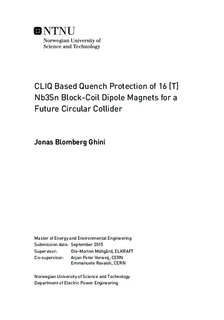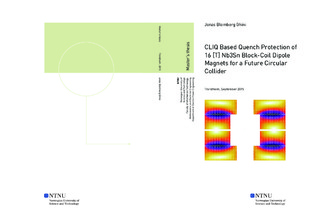| dc.description.abstract | Protection of large high-field, high-energy accelerator magnets is very challenging with current technology. To avoid damage to the magnet coil by local or global overheating, the maximum temperature in the hot-spot of the magnet coil must be kept under certain levels depending on the materials used in the coil construction. The current state of the art technology seems unable to do so.
A novel protection system for large superconducting magnets based on generating Inter Filament Coupling Loss through current oscillations in the magnet circuit is applied and simulated successfully for the Nb3Sn block-coil dipole magnet intended for use in a 100 [TeV] Future Circular Collider.
The proposed protection system is able to keep the maximum temperature of the magnet coil during a quench below 350 [K] at nominal operating conditions, system parameters and geometry, and is shown to achieve a maximum temperature in the coil hot-spot as low as 260 [K] for the optimal protection system configuration.
Several variations on the nominal coil geometry have been investigated, showing that an increase in inductance is detrimental while a reduction is beneficial from the point of view of the new protection system.
Among the variations investigated are a graded coil and a coil with a larger aperture than the nominal geometry. The graded coil is found the most difficult to protect, while the larger aperture coil variant is the easiest to protect, with regards to the hot-spot temperature.
A large parameter space has been investigated, and the most influential parameters are found to alter the hot-spot temperature by 50 [K], while the least influential by 10 [K] when moving away from their respective nominal values. Most influential are the electrical configuration of the protection system, the non-Copper content of the superconducting strands and the coil geometry. Least influential are the residual resistivity ratio and filament twist pitch.
Taking the internal voltages to ground in the coil during application of the new protection system into account, the graded coil must be discarded completely, as turn-to-turn voltages can reach several hundred volt. The reduced inductance variants, therein the larger aperture one, proves the optimal also with respect to voltage: the turn-to-turn voltages are kept well below 100 [V], while the inter-layer voltage, critical for the application of the new protection system, only barely exceeds 1 [kV]. | |

